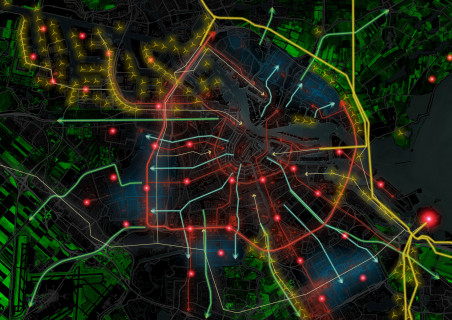Using flow analysis to validate and quantify the spatial impact of measurements for circularity and using urban design to see how these measurements can be integrated in the context of the city.
More information can be found in my booklet. Or for further information or requests I can be contacted. I will be happy to try and answer the questions/requests.
Meaningful Circular Metabolism
Meaningful Circulair Metabolism
What is the goal of the project?
The project focuses on the field of flow analysis and urban design. It is about the spatial impact of urban metabolism. When urban metabolism is an integrated part of the design on the city of Amsterdam. This means I take the theory of urban metabolism as a base and use design goals such as circularity and sustainability. This to see how a city would look if circularity were to be implemented in the city being quantified and integrated in their real size. The spatial component is often lacking and therefore the impact of urban metabolism on urban design is not well established. This graduation project focuses on bridging that gap.
What is the result of the project?
The main products of this graduation are a new pattern language to map difficult/technical interventions in spatial tiles, a GIS model for assessing urban metabolism potentials and restrictions and a new approach for applying urban metabolism measurements on neighbourhood level.
Who initiated the project and which organizations are involved?
This thesis report was done as part of the graduation of the master track Urbanism, at the TU Delft. The design studio was on urban metabolism. It was done partially through the AMS (advanced metropolitan solutions).
What is the next step?
The next step of the projects would be speak/be in contact with engineers and specialist to further improve the GIS model. The assumptions for the interventions in the GIS can be discussed, improved and validated.
The idea is also to continue to work on the spatial tiles and the design to create a better communication language so urban designers and planners can more easily design with these interventions, helping to create more sustainable cities.
And hopefully using and applying the GIS model in practice, since now it has only been tested for geothermal in Amsterdam.
What can other cities learn from your project?
The GIS model for assessing circular interventions can be a helpful tool for cities. Showing where in the city interventions are (im)possible and (un)favorable. Making quick scan for the city with the GIS model can show where which intervention has the most potential in an area to achieve circularity.
While the spatial tiles can help to make the complex literature/regulation of these interventions to be spatially depicted, making it easier to communicate through the different actors.
The design process followed in the projects helps to make spatial explorations for the location. This simple design exercise shows how much it is possible and whether it is desirable, as it shows quantified impact and spatial impact. This can also help communicate to residents and parties in the discussion as to what it produces and whether it is desirable. By the design process we can create the added value of circularity, such as economic or social.





